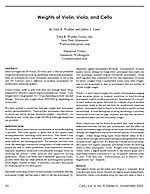 Publication: CAS Journal, November 2003
Publication: CAS Journal, November 2003
The Catgut Acoustical Society
Weights of Violin, Viola, and Cello
By John R. Waddle, Waddle Violins, Saint Paul, Minnesota and Jeffrey S. Loen, Kenmore Violins, Kenmore, Washington
Download PDF of full article
ABSTRACT
Data on weights for 80 violins, 20 violas, and 11 celli are presented along with descriptions of set up and fittings used on each instrument. Data are presented for classic European instruments as old as the late 16th Century, plus a selection of modern instruments by professional American makers.
Violins, ready to play with chin rest, weigh from under 400 grams. very occasionally, to over 500 grams. Usually the heavier violins are not the best sounding ones. Viola weights show a large spread (511-731 g), depending on body size and fittings. Full-size celli weigh about 2600-3500 g. When an instrument is heavy, it is because either the wood used to make it was too dense, or it was left too thick, or both. There is a physics formula, F=MA, which means, in basic terms, that the heavier an object is, the more force it takes to get it to move. Since stringed instruments have to vibrate to make sound, the lighter they are, the easier it will be to get the sound to start, and the more sound should come out.
We have noticed a correlation between weight and instrument quality and marketability. There are few instruments that interest us above and below certain threshold weights. Specifically, we often favor new violins that weigh under 460 g. There are exceptions to every rule, and in violins, there are good sounding instruments that weight more than this, but usually the lighter the better.
Enjoy the article!